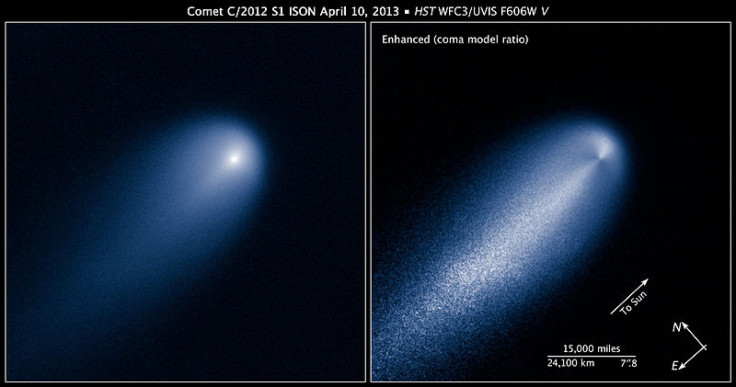Comet Ison Conspiracy Theory: Is The 'Comet Of The Century' Actually Three Objects?

Comet Ison is fast approaching, and recent views of the "comet of the century" have led to some speculate that it is actually three objects or even an Unidentified Flying Object. Of course, the Space Telescope Science Institute debunked those claims and on Wednesday, beginning at 10:30 p.m. PDT (1:30 a.m. EDT), SLOOH, an international team of experts and astronomers will host a live chat to talk about the Comet Ison conspiracy theories.
Comet C/2012 S1 was first discovered in 2012 and originated in the Oort Cloud, located at the edge of our solar system. As noted by Hubble, Comet Ison is considered a long-period comet and its orbit around the Sun will be the first, and only, time it will ever be seen from Earth. The likely fate of Ison will either be getting destroyed as it passes around the sun or returns to the Oort Cloud. Another famous long-period comet that originated in the Oort Cloud was Comet Hale-Bopp, while a famous example of a "short-term" comet (75 years), with a regular orbit, is Halley's Comet.
Comet Ison's orbit will have it travel extremely close to the Sun, approximately 800,000 miles (1.2 kilometers) from the surface of the star, making it a "sungrazer," notes Hubble's Ison blog. A comet is made up of dust, ice and other debris, and those components will heat up as the comet pass around the sun, creating a bright tail. There is a possibility that Comet Ison will be incredibly bright and will be visible to the naked eye during broad daylight.
The conspiracy notions surrounding Ison are not malicious and are more to do with perspective, not the unknown. There is no chance Comet Ison will hit Earth, as the closest it will get to the planet will be about 40 million miles (65 million kilometers), notes the Space Telescope Science Institute. The Comet Ison UFO conspiracy theory comes from a combination of three images, from different perspectives, captured by Hubble.
There is still plenty of time before Comet Ison becomes visible without the aid of a telescope, expected to be in November, but it will soon be visible to many astronomers as it approaches Mars. Comet Ison is expected to pass near Mars on Oct 1. and will be visible with a telescope.
SLOOH's live chat will discuss the Comet Ison conspiracies as well as the comet itself. Viewers tuning in can ask questions and learn more about the possible "comet of the century" beginning at 10:30 p.m. PDT (1:30 a.m EDT); the live stream can be viewed below.
© Copyright IBTimes 2025. All rights reserved.






















